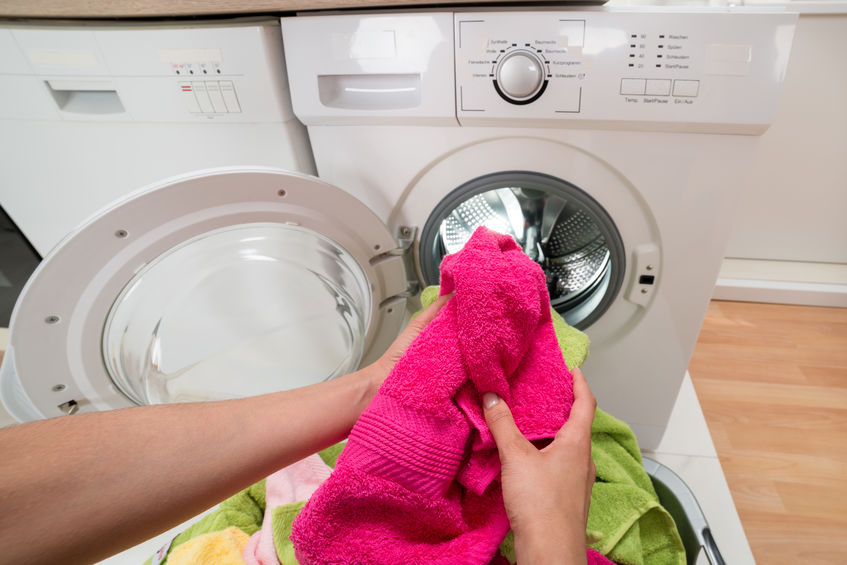- Clean Home
- Laundry Tips & Techniques
- How To Wash Clothes
How to Wash Clothes: Laundry 101
Don't feel guilty if you've forgotten the basics on how to wash clothes that Mom taught you. This refresher course will have you sorting a load, selecting detergent, and setting the machine like a pro in no time.
Your studious efforts in the laundry room will be rewarded with clothes that last longer and look better, too.
Here's how to sort and wash clothes so they come out looking their best every time.
How to Wash Clothes the Right Way
How to wash clothes? Success in the laundry room requires good old-fashioned preparation.
The quickest way to do laundry is to separate the whites, medium colors, and darks, and wash each load in cold water. But the time you save in the short run may actually double your wash-day workload later.
Cold water doesn't clean some dirty fabrics nearly as well as warmer temperatures; it can leave them looking dingy and worn instead of bright and clean.
And you'll be back in the store or online looking for new jeans or Oxford shirts sooner than if you had taken a few moments to wash them the way the manufacturers suggest.
Prep your dirty duds for a spin in the washing machine before you toss them in the clothes hamper. Essential preparation tips to keep them safe in the tub.
- Zip zippers, snap snaps, fasten hooks, and tie laces together.
- Turn down cuffs on pants or shirts; brush away dirt and lint.
- Make sure all pockets are empty.
- Remove belts, pins, and other decorations.
- Turn clothes inside out to keep abrasion from fading them.
Taking care of these odds and ends will ensure that important notes tucked in a shirt pocket won't come out blank and that hooks and zippers won't snag other fabrics in the wash cycle. It's how to wash clothes the right way.
The secret to getting everything clean safely is to sort your laundry into loads of similar colors, wash cycles, and water temperatures, and to set aside stained garments for prewash TLC.
Look to the clothing care labels on your garments for guidance. They make selecting the proper machine settings simple.
Today's international care labels often have symbols as well as, or instead of, words. Most of the symbols are self-explanatory. A cuplike icon with dots tells you the wash temperature (one for cool/cold, three for hot).
A simple circle indicates clothes that should be dry-cleaned, and a circle overlaid with an X identifies garments that should never be sent to the dry cleaner.
How to wash clothes - and when not to. But when clothes are labeled dry-clean only, must you obey? The dry-cleaning industry will tell you, yes, and if you can't live without that silk blouse, you should comply.
If you clean it yourself, you risk damage like shrinkage, color loss, or fading, and fabric texture changes - silk can lose its sheen, and linen can end up looking lumpy instead of crisp.
The benefits: If you don't mind gambling, you save money and have the item ready when you need it.
Your best hand-washing bets (cold water, please) include plain-weave light-colored silks, cashmere (washed inside out), fuzzy sweaters, and fancy loose-weave knits.
While dry cleaning will keep those clothes looking new longer, some of these may be carefully hand-washed and air-dried.
Sorting Made Simple
How to wash clothes? Start sorting by reading each garment's label and separating clothes into six piles for washing:
- Cold-water whites
- Warm-water whites
- Cold-water pastels and light colors
- Warm-water pastels and light colors
- Cold-water brights and darks
- Warm water brights and darks
Of course, six piles could translate into six loads; if you've got the time during the evening, this is how to wash clothes to right way. It's also the safest way to keep your clothes looking good.
However, if time is short and your needs are immediate, here's how to wash clothes quickly and safely.
Combine and wash the cold-water pastels and the light colors with the cold-water brights and darks; do the same for your warm-water loads. But resist the temptation to mix any colors with white loads.
As you sort, be on the lookout for items that have spills or stains ( see this stain removal guide for tips on removing common stains), really grungy jeans and kids' clothes (very dirty garments can transfer dirt in the wash to lightly soiled clothes), and those that require a gentle wash cycle.
Create three separate stacks for these: hot water, gentle cycle, and pretreat.
Once again, you can mix things up in a pinch: If you have only a few light-colored cold- or warm-wash items that require the gentle cycle, throw in similarly colored items that need the same temperature.
The add-ins won't get as clean with the gentle cycle's agitation, but it's OK to simplify your laundry life. Still, always go with the gentlest cycle and the coolest temperature when mixing fabrics and colors.
Hot, Warm, or Cold?
It's time to select a wash cycle and laundry temperature.
Here's how to wash clothes if some fabric labels are no longer legible.
Let your fabrics determine the cycle if the label doesn't tell you: sturdy fabrics, such as jeans and heavy cotton shirts, use the normal or regular cycle; combinations of synthetic and natural fibers use the permanent-press cycle; and sheer and delicate fabrics do best in the gentle cycle.
How important is the right laundry temperature? Very. It directly affects the performance of the laundry detergent, the wrinkling of fabrics, and the life span of your clothes - so follow the care labels.
If a label is not legible, remember that hot water works well on ground-in and hard-to-remove dirt on sturdy fabrics. Still, few labels recommend regular hot-water washing.
Use it to clean seriously soiled garments (gardening or children's clothing), and to regularly disinfect dish towels, washcloths, bath towels, bedding, and pillowcases.
This is one time you don't want to mix lights and darks, as hotter temperatures can cause some fabrics to bleed. (Whites warrant the solo treatment no matter what the temperature.)
Warm water minimizes color fading and wrinkling. Choose it for washing synthetic fibers, natural and synthetic blends, and moderately soiled fabrics.
Cold water will protect most dark or light-colored clothing from running and minimize shrinkage in washable woolens. Use it for lightly soiled clothes and those with blood, wine, or coffee stains (which may set if washed in warm or hot water), regardless of the fabric.
If you're going to do a cold-water wash, check first for stains and spots and pretreat garments; detergent doesn't clean heavily soiled areas as well in cold water.
If you do a lot of cold-water washes, consider using a laundry detergent designed to work at all temperatures.
But for the rinse cycle, cold water is excellent for all types of loads. Another benefit: A cold-water rinse can reduce the energy used per load by up to one-third and minimize wrinkling in synthetic and permanent-press fabrics.
Ready, Set, Wash
Adjust your machine's water level to match your load size, then select your cycle. Add detergent and fill the tub before you load your clothes.
Wash-Day Products Defined
Here's a quick review to help you decide which of the many products available would be best for specific laundry situations.
Prewash stain removers are available in stick, liquid, aerosol, or pump-spray forms. These products go directly on a stain or spot to loosen the grime before you machine-wash.
Chlorine bleaches These liquids boost laundry detergent while cleaning, whitening, sanitizing, and deodorizing your wash; they are usually safe on white and colorfast cotton, linen, and washable synthetics.
Oxygen bleaches These kinder, gentler bleaches are safe for most washable colored fabrics.
How to wash clothes by soil level and load size. If your load is average (5 to 7 pounds, 2-3kg), with moderate soil, and you use warm water, follow the product's directions. Use more if the clothes are really grungy, if the load is full, or if you're using cold water.
Place clothes loosely in the washer, taking care not to wrap items around the agitator, where they could become tangled during the cycle.
Know when to say when: Clothes should move freely through the water for optimal cleaning. If you're not sure, lift the lid during the cycle. Properly loaded clothes should sink and then reappear on the surface.
Overloading causes clothes to rub together - breaking down the fibers - and reduces the effectiveness of your laundry detergent; it also allows dirt to be redeposited on clothes instead of heading down the drain with the rinse water.
If you're using chlorine bleach to help your detergent brighten whites or clean heavily soiled clothes, add it to the dispenser after your wash load has agitated for about five minutes so that the bleach can fully work its magic.
Bleach assists your detergent by converting dirt into more soluble particles.
If you're using an oxygen (color-safe) bleach, add it at the same time as you add the detergent, but put the bleach directly in the water before you add clothes, not in the bleach dispenser.
The thicker liquid can clog the dispenser. Don't use both types of bleach at the same time - they can neutralize each other's effectiveness.
A simpler alternative to adding bleach is to buy and use a detergent that contains bleach (either the chlorine type or a color-safe alternative).
Then you won't need to go through the extra step of adding a separate bleach to the wash - although adding a little more of the appropriate type of bleach won't hurt, either.
Dry Right
If you have several small loads, dry them together to protect your clothes from heat damage and to hasten the drying process.
Drying small loads reduces the tumbling effect produced by a pile of clothes rotating all together, and therefore actually prolongs the amount of time it can take to dry the clothes.
Set the dryer cycle to Regular or High if your load is all cotton (and preshrunk) fabrics; choose Permanent Press if the load consists of polyester or other synthetic fabrics; select the Low, Gentle, Delicate, or Air-Dry setting for fragile or sheer fabrics.
How long should you dry a load? If you have a full load of towels, choose the longest time - very dry.
For most clothes, a standard setting will dry them without overheating. A few thick towels or blue jeans may still come out slightly damp, but it's safer to line-dry those the rest of the way than to risk overdrying the remaining items in the load.
If your load is a mix of fabrics, use the cycle and temperature (or the shortest drying time) that's recommended for the most delicate fabrics.
When the dryer stops, remove the dry items, then restart the dryer to finish the load.
Do you need a fabric softener? Many people swear by these products, finding that they make clothes soft and fluffy, reduce wrinkles, prevent static cling, and make ironing easier.
If you do include fabric softeners in your wash-day routine, use the recommended amount; too much can cause towels and similar items to lose absorbency. Now you know how to wash clothes from start to soft, fluffy finish!
- Clean Home
- Laundry Tips & Techniques
- How To Wash Clothes














